Posts Tagged ‘Leonardo Da Vinci’
-
Christmas inspiration
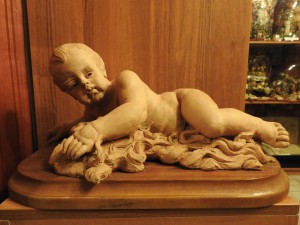 Thousands of baby Jesus statues begged for my attention during a visit at Il-Mużew tal-Bambini in Birkirkara. However, I felt mostly intrigued by a particular terracotta figure which looked completely different from the rest. Its face had captivatingly unique features and the rest of the body was very life like. Yet it was only when I met its creator, sculptor Chris Ebejer, that I understood its real value, since that baby Jesus was not just a statue but a singular work of art.
Thousands of baby Jesus statues begged for my attention during a visit at Il-Mużew tal-Bambini in Birkirkara. However, I felt mostly intrigued by a particular terracotta figure which looked completely different from the rest. Its face had captivatingly unique features and the rest of the body was very life like. Yet it was only when I met its creator, sculptor Chris Ebejer, that I understood its real value, since that baby Jesus was not just a statue but a singular work of art.“My baby Jesus creations are not popular statues that are meant for domestic use or simply to act as a representation of the son of God. They have an added value because they are sculptures and not just statues,” explained Chris when I met him at his studio in Mqabba.
“When I do such works, my aim is not only to reproduce the tenderness of a baby but also to relay an artistic style and a distinct message. Such art pieces are not restricted just to the Christmas season but they can be cherished all throughout the year due to their artistic significance.”
An unfinished terracotta sculpture of a toddler Jesus lay waiting on a workbench. I couldn’t help noticing some subtle facial similarities between this work and the other one that I had viewed before. I was curious to know whether a sculptor would have a specific image in mind of how Jesus should be represented.
“Before starting to work on something, an artist needs to have a vision of what he intends to create. One wouldn’t picture the exact image in mind but there would already be an idea of the shape, the composition, and the layout of the figure. Details will not be clear but each artist will subconsciously compose some particular features which are typical of his style.”
“I must say that the facial features of this figure were inspired by those of my nephew. When he was a baby and later on a toddler, I studied closely his facial characteristics in order to explore the difference that exists between such a young face and that of an adult. For example, I observed that a toddler’s forehead is large when compared to the rest of the face, the upper lip is usually protruding, the cheeks are chubby and the neck is fleshy.”
The sculpted figure of Jesus looked quite human and earthly and I wondered whether such work involved a spiritual process as well?
“Whenever I am creating a sculpture, my foremost thought is always art. I am not motivated by any religious intentions and I do not aspire to encourage faith or to have people praying in front of my work. I have to admit that the subject is irrelevant to me.”
Nonetheless, although creativity and originality are always his primary goals, Chris revealed that there is a limit on how much one can move out of the religious figures’ codified facial characteristics which our culture has learnt to decipher and expect.
“No one has any idea how Jesus actually looked like, neither as a baby or a child, nor as an adult. Indeed, both his face and the way in which he is represented have changed considerably along the centuries. The belief that some images such as the Veil of the Veronica and the Shroud of Turin could be historically authentic has influenced very much the present impression of Jesus’s face. Once such images are portrayed over and over again and are accepted by society, their characteristics become codified and this will help people to recognize immediately the figure of Jesus. Certainly, as an artist, there are ways and means of how to be creative when dealing with such a significant figure. However, one must know his limits so as not to come out with a profane work.”
In earlier times, when art could reach out to people more than books, especially due to widespread illiteracy, the Catholic Church often used symbols within artistic works to deliver its messages.
“There were various symbols that were portrayed with baby Jesus. In Botticelli’s artwork Madonna of the Pomegranate, Jesus is holding a pomegranate in representation of his suffering and resurrection. On the other hand, in the Madonna of the Carnation by Leonardo da Vinci, Jesus is reaching out to a carnation which is the symbol of Passion.”
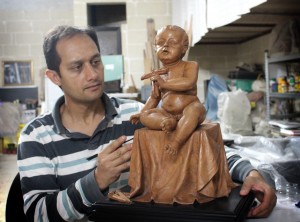 Chris pointed out to his sculpture of toddler Jesus where he had also included such symbols.
Chris pointed out to his sculpture of toddler Jesus where he had also included such symbols.“Although in this sculpture, Jesus might look just like any child, there are a number of clues which will hint to the viewer that there is more to it than that. In fact, the child in sitting on a humble box draped in cloth in allusion to when the babies of ancient royal families were placed on thrones. The young figure is holding a miniature cross in his hand and three nails lie down beneath him on the ground. All these objects, together with the boy’s meditative expression as he looks far out beyond his tender age, create an effect which suggests that the child is already seeing his mission for the future.”
As he continues with some final touches on this latest sculpture, Chris reveals that the autumn and wintery seasons tend to inspire him to create new works.
“I am deeply influenced by the change of seasons and by the transformation which they breed in the coloured landscape. Being from the rural village of Qrendi, I am very attracted to nature and my senses are intensely attuned to it. As the leaves start turning orangey red, melting in with the aroma of wet brown soil and the liquorish scent of carobs, I feel stimulated to think about Christmas and the birth and life of Jesus, and it is mainly during this period when I come up with new ideas for works with religious themes. Moreover, the earlier approach of night during these days entices me to stay more indoors and this provides me with much more time to work.”
A look at some of his finished works that were in his studio indicated that this sculptor had a particular preference to terracotta.
“I do love working with terracotta as besides being a natural medium, it also has a pleasant warm colour. It is also more fluid and softer to handle than other materials and so it allows me to work in greater tranquillity. The fact that terracotta has been in use since ancient times enhances also in me that sublime feeling that by utilising this medium, I am helping to keep this traditional technique alive.”
Apart from baby Jesus sculptures, during this season, Chris tends also to come out with new nativity creations.
“Tenderness and the love for the family are the main messages imbued in these works.”
(This article was published in Christmas Times magazine issued with The Times of Malta dated 8th December 2016)
-
A Traditional Crib
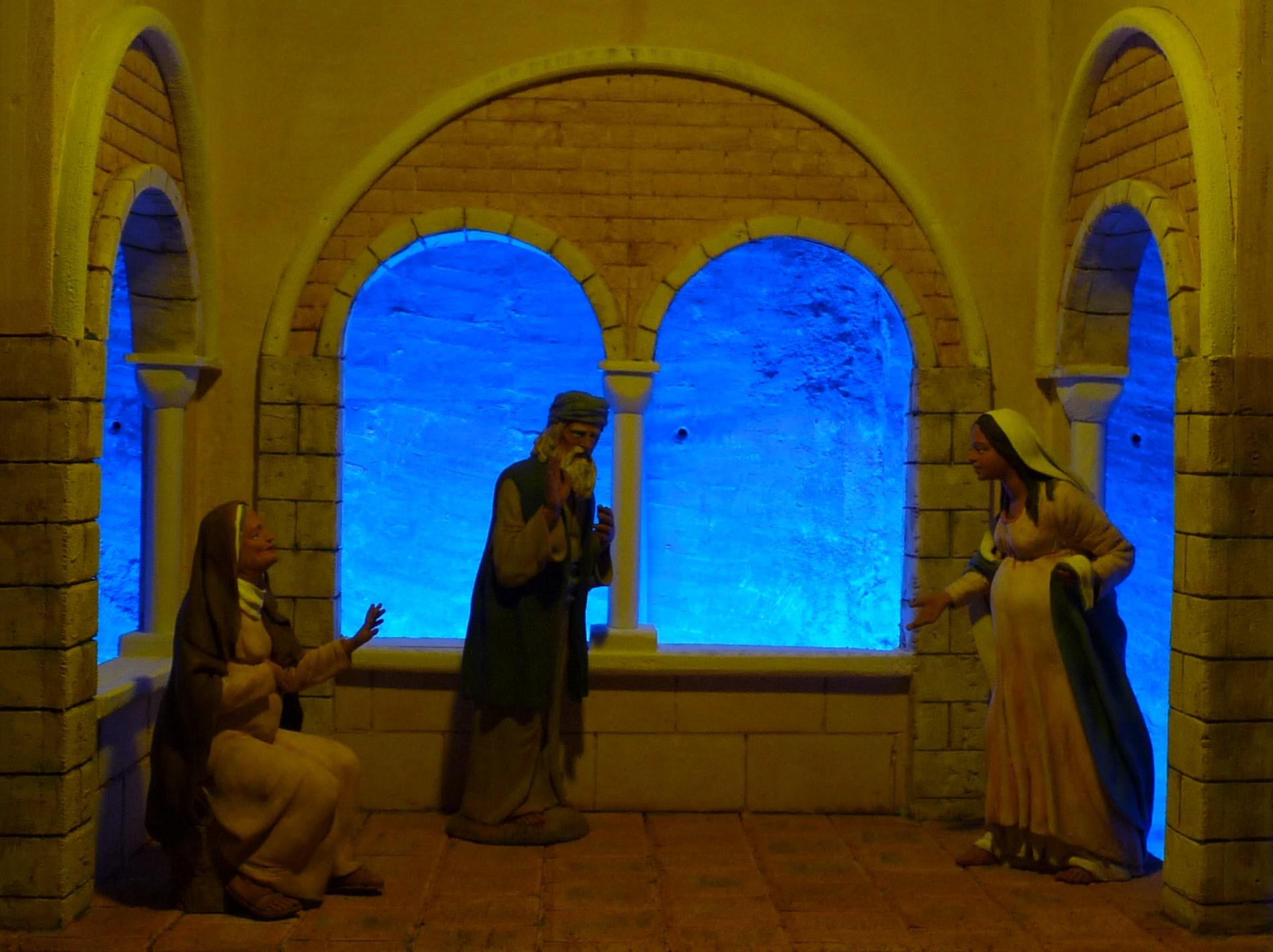
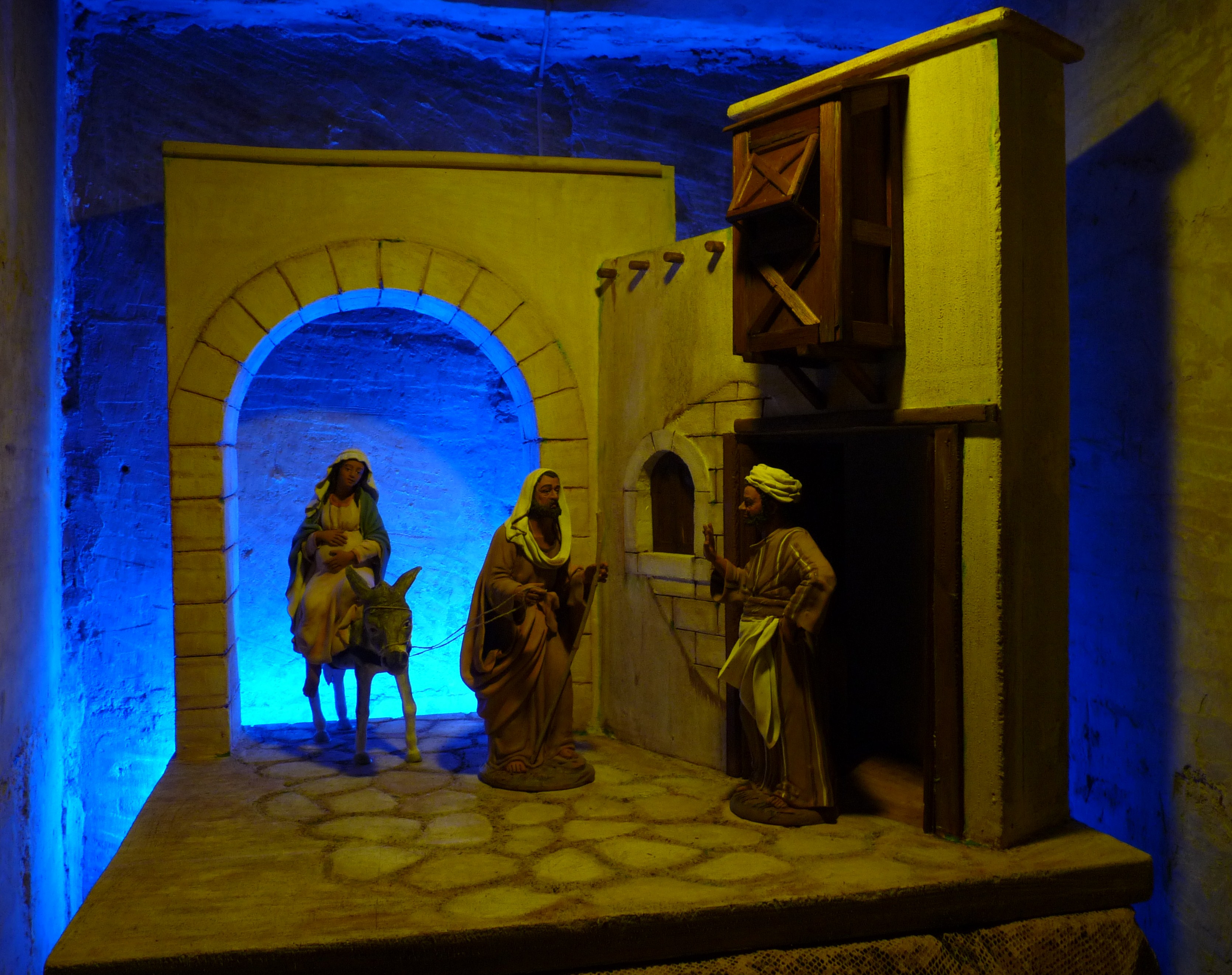
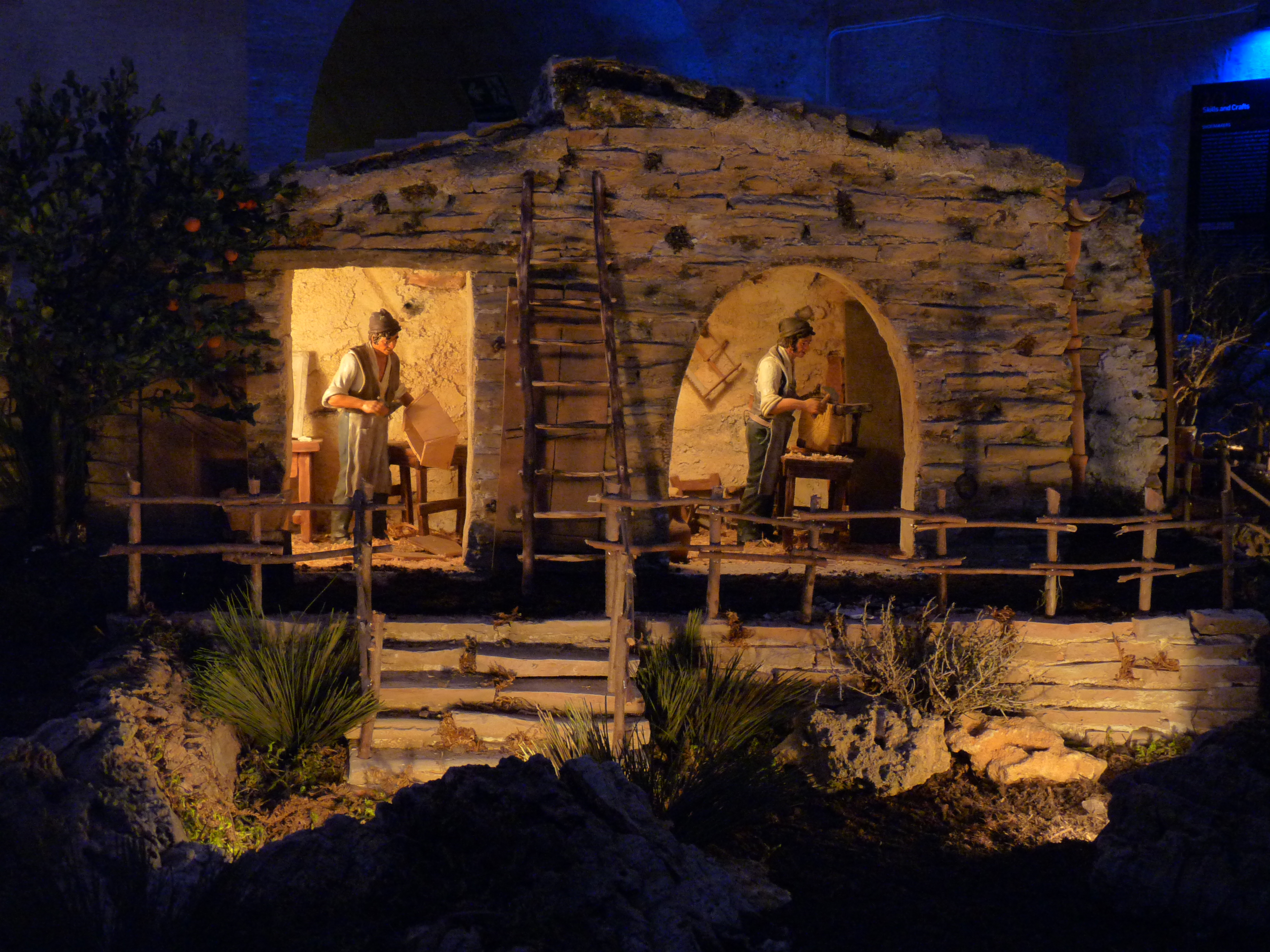
“The setting up of a crib during the Christmas season has become a worldwide tradition. However probably, few are aware that by doing this, they are reproducing a custom that was originated by St Francis D’Assisi in the 13th century,” told me Francesca Cannavò, the Curator of the Nativity Museum which is located in the crypt of St Augustine’s Church in Old Mint Street, Valletta.
“The main aim of this museum is to promote a deeper understanding and meaning regarding the nativity of Jesus and how this sacred event has been represented artistically during all these years by various artists,” explained Andrea Consalvo Rifici, the marketing manager.
Indeed, during these last months, the ambience of this huge crypt has been completely transformed into a landscape which instills the perception of being absorbed back in time, right to the period of this holy nativity.
“We want the visitors to walk around this place and to meditate about what was happenning in the days before baby Jesus was born and also what took place soon after.”
Various panels with interesting information accompany the visitors throughout this journey which takes them deep within the old crypt in search of the revelation of the Christmas story. Meanwhile, heavenly music engages the visitors and immerses them into the sanctity of this experience.
“In the old days, many of the people were uneducated and so they could not read the scriptures. Therefore, the Church set up various plays and commissioned many paintings in order to create a visual narrative with which the people could comprehend certain episodes in Jesus’ life.”
In fact, beautiful reproductions of renowned artistic works that portray the nativity scene compliment and enhance the significance of this museum, as the visitors can enjoy and absorb the different interpretations that were effected by remarkable painters such as Leonardo da Vinci, Giotto, Tiziano, Rubens, Botticelli, Carvaggio, Fra Angelico, and Hugo van der Goes.
“It is believed that these representations of the nativity have inspired St Francis of Assisi to compose the first crib which he set up in a cave. Eventually, this idea was so much appreciated by the people that they decided to produce their own cribs in order to possess the blessed nativity scene within their homes. As years passed, people continued to develop this concept by designing new ways of expressing this remarkable episode.”
A circular room within this crypt has been selected to present a set of artistic scenes which manifest the main events that are relative to the birth of Jesus; such as that of the Annunciation, the dream of Joseph, Mary’s visit to a pregnant elder Elizabeth, the search to find a place for Mary to give birth and the hasty escape to Egypt.
“These set ups have been designed in Sicily in order to decorate this museum. The figurines were made by Vincenzo Velardita in Caltagirone whereas the scenography was realized by Gigi Genovese in Catania. We tried to keep these scenes as simple as possible in order to reflect the modest nature that Jesus Himself chose for his own birthplace.”
Certainly, the principal attraction in this nativity museum is the huge crib with its numerous mechanical figures.
“This crib is the work of Salvatore Milazzo from Caltagirone. We are proud to say that it has been admired in several countries and that it has received various prestigious awards. This year, we decided to introduce it to Malta because we are aware that the Maltese people are deeply devoted to the nativity of Jesus. Moreover, we wanted to share our Sicilian culture with the Maltese people since there are many similarities between our culture and traditions.”
Milazzo’s work is definitely a work of art as it embraces within it all the skill of the renowned Caltagirone masters of this trade. The forty square metre crib has been decorated with a typical Sicilian country lansdcape of the 1800s which includes also a number of workshops of trades which do not exist any longer.
Meanwhile, this museum incorporates within it also a number of locally made cribs that were provided by members of Friends of the Crib (Malta).
Interestingly, this nativity museum which has opened its doors for the public in November will not close after the Christmas season and it will remain available to visitors all throughout the year.
“The concept behind the creation of this nativity museum in Malta is to heighten the experience of Valletta 2018 both to local and to foreign visitors, by blending together the culture of this island and that of Sicily.”
(This article was published in CHRISTMAS TIMES Magazine which was issued with The Times of Malta dated 13th December 2014)
-
WIRJA TAL-ĠIMGĦA MQADDSA – wirja bi skop
Fil-ħajja kultant jiġu mumenti meta tibda titħasseb jekk Alla jeżistix tassew f’ħajjitna. Partikolarment meta jseħħu traġedji kbar u tara popli sħaħ jinkinsu qishom nemel mejtin, jiġik id-dubju jekk wara kollox hux qegħdin weħidna hawn isfel u li m’hemm ħadd jieħu ħsiebna fir-realtà! Ħsibijiet koroh ħafna li jqanqlu fik emozzjonijiet ta’ disperazzjoni li tħosshom iridu jiklulek qalbek. Diffiċli l-ħajja meta tgħolli għajnejk il-fuq lejn is-sema kaħlana u moħħok jgħidlek li dak hu l-limitu tal-eżistenza tiegħek u li m’hemm xejn aktar. Iebsa wisq biex taċċetta li m’hemm l-ebda entità lejn min tista’ tirrivolġi għall-għajnuna u li dak li ġejt mgħallma u li emmint matul ħajtek kollha huwa biss gidba.
Biex tgħaqqad, l-atteġġjament ta’ wħud minn dawk li jagħżlu li jkunu r-rappreżentanti tal-messaġġ t’Alla, xi kultant aktar jitfgħek fil-limbu milli jurik id-dawl. Nagħżel biss illi nsemmi każ li seħħ il-ġimgħa li għaddiet fejn għad-diżappunt u l-inkredultà tal-familjari u l-mistednin, tarbija ta’ koppja mhux miżżewġa, ġiet mgħammda għaliha weħidha, f’sala ta’ knisja u wara li spiċċat il-quddiesa u telaq kulħadd il-barra! U dan meta waqt il-quddiesa, smajna priedka mqanqla mill-qassis b’messaġġi kontinwi ta’ tolleranza u mħabba filwaqt li fl-istess ħin, f’rokna mwarrba f’dak il-post, kien hemm dit-tarbija u l-ġenituri tagħha jistennew ħalli titgħammed. Tgħid Kristu hekk kien jagħmel kieku għex dis-sitwazzjoni? Nitbissem meta mbagħad jiġi xi ħadd jistagħġeb il-għala qed jonqsu n-nies mill-Knisja!
Iżda trid jew ma tridx, bosta drabi jkollok tagħraf illi għandek bżonn li temmen sabiex tkun tista’ tibqa’ għaddej. U għalhekk, meta tiltaqa’ ma’ grupp ta’ żgħażagħ jaħdmu mimlija fiduċja u ħeġġa sabiex jiċċelebraw dal-ġranet tal-Ġimgħa Mqaddsa, qalbek donnha tistejqer u fik terġa’ tinbet dik il-fjamma li tkun għoddha ntfiet….
Ryan Bezzina, il-viċi Chairman tal-Kummissjoni Festa Esterna –Fgura laqgħani ġewwa l-Knisja l-Antika tal-Fgura. Flimkien ma’ sħabu, huwa kien qiegħed ilesti l-aħħar preparamenti sabiex tittella’ l-wirja annwali tal-Ġimgħa l-Kbira.
“Flimkien ma’ missieri Raymond u l-Kummissjoni, ilni ntella’ din il-wirja għal dawn l-aħħar sitt snin,” beda d-diskors Ryan. “Fil-fatt kien missieri stess li rawwimni f’dan il-qasam. Sa minn meta kont żgħir,
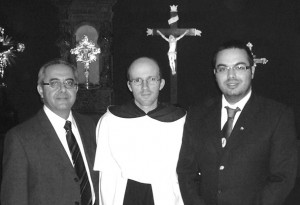 kont narah jgħin fl-armar tal-festa u maż-żmien anki jiena bdejt immidd idi. Ftit wara beda jitħajjar jixtri xi statwa żgħira u minn hemm id-delizzju kiber tant li missieri beda jikkollezzjona sett ta’ vari tal-Ġimgħa l-Kbira. Iżda wara xi snin iddeċieda li jieqaf u minfloku għażilt li nkompli nibni s-sett jien. Sadanittant bdejna ninteressaw ruħna wkoll f’xi oġġetti antiki tal-arti sagra. Meta rawni daqshekk iddedikat, sħabi ħajjruni ntella’ wirja u ddeċidejt li nipprova. Flimkien mal-Kummissjoni u permezz ta’ xi kollezzjonijiet privati oħra, jiena u missieri bdejna ntellgħu wirja annwali fejn kull sena, inżidu xi ħaġa ġdida. Nistgħu ngħidu li kollox beda minn sett ta’ vari żgħar!”
kont narah jgħin fl-armar tal-festa u maż-żmien anki jiena bdejt immidd idi. Ftit wara beda jitħajjar jixtri xi statwa żgħira u minn hemm id-delizzju kiber tant li missieri beda jikkollezzjona sett ta’ vari tal-Ġimgħa l-Kbira. Iżda wara xi snin iddeċieda li jieqaf u minfloku għażilt li nkompli nibni s-sett jien. Sadanittant bdejna ninteressaw ruħna wkoll f’xi oġġetti antiki tal-arti sagra. Meta rawni daqshekk iddedikat, sħabi ħajjruni ntella’ wirja u ddeċidejt li nipprova. Flimkien mal-Kummissjoni u permezz ta’ xi kollezzjonijiet privati oħra, jiena u missieri bdejna ntellgħu wirja annwali fejn kull sena, inżidu xi ħaġa ġdida. Nistgħu ngħidu li kollox beda minn sett ta’ vari żgħar!”Il-wirja hija mqassma f’erbgħa sezzjonijiet…
“Aħna nippruvaw nolqtu d-diversi interessi ta’ dawk kollha li jiġu jżuru din il-wirja li daqs kemm kibret illum, aktar tista’ ssejħilha esebizzjoni. Fil-fatt in-nies timxi matul xenarji mibnija apposta u tittieħed minn sezzjoni għall-oħra akkompanjata minn selezzjoni professjonali ta’ dawl u mużika sagra. L-iskop tal-wirja huwa li ndaħħlu lin-nies fl-atmosfera tal-Ġimgħa Mqaddsa, nifhmu aktar il-passjoni ta’ Kristu u x’tirrappreżenta l-Ġimgħa l-Kbira u f’dan kollu ndaħħlu wkoll it-tradizzjonijiet lokali.
L-ewwel sezzjoni, eżatt kif tidħol, tikkonsisti f’sett ta’ vari tradizzjonali li magħhom insibu wkoll xogħol ta’ fidda, skultura, rakkmu mill-isbaħ u fin-nofs kurċifiss antik tal-kartapesta. Interessanti nsemmi wkoll illi hawnhekk ser ninkludu wkoll ventartal antik (artal li jintrama quddiem l-artali għall-okkażżjoni) u karti tal-glorja fi tlieta (li dari kienu jitqiegħdu fuq l-artali biex tingħad il-quddiesa minn fuqhom).
It-tieni sezzjoni ser tkun imżejjna b’xenarju msejjes fuq il-pittura tal-aħħar ċena ta’ Leonardo Da Vinci fejn hemmhekk in-nies tista’ tara l-mejda tal-appostli armata bi stil Lhudi, eżatt kif jingħad li kienet fl-aħħar ikla li għamel Kristu magħhom. F’din il-parti jispikka ħafna x-xogħol tal-platti tal-ismid fostom il-platti bl-ismijiet tal-appostli.
It-tielet sezzjoni hija dik li l-aktar li timpressjona n-nies u fiha nsibu statwi life-size. Kemm l-istatwi u kemm ix-xenarju li jdawwarhom huma maħduma fuq il-film The Passion of The Christ. Għażilna dan l-
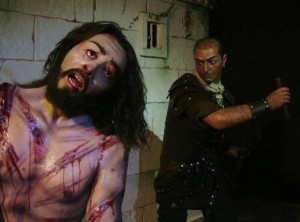 istil peress li jidhrilna li dan il-film kien l-aktar wieħed qawwi u realistiku. L-ewwel ma ħdimna kienet l-istatwa ta’ Kristu u din mall-ewwel laqtet ħafna lil kull min ġie jaraha. L-iskultura tagħha hija xogħol ta’ James Azzopardi min-Nadur. L-oriġinalità tal-istatwa toħroġ l-aktar peress li din mhiex imlibbsa parrokka (kif soltu jkunu statwi bħal dawn.) Minflok din għandha x-xagħar tar-ras u s-suf tal-ġisem, imdaħħlin waħda waħda minn ġilda partikolari tal-fibre li jagħtu lill-istatwa s-sensazzoni ta’ ġilda ta’ bniedem veru, meta tmissha. Bl-istess mod, inħadem ukoll is-suldat il-manigold li jidher qiegħed isawwat lil Kristu. Ta’ min isemmi li dis-sena f’dix-xena ser jiżdied ukoll iċ-ċenturjun bil-qiegħda qed jgħodd is-swat ta’ Kristu.
istil peress li jidhrilna li dan il-film kien l-aktar wieħed qawwi u realistiku. L-ewwel ma ħdimna kienet l-istatwa ta’ Kristu u din mall-ewwel laqtet ħafna lil kull min ġie jaraha. L-iskultura tagħha hija xogħol ta’ James Azzopardi min-Nadur. L-oriġinalità tal-istatwa toħroġ l-aktar peress li din mhiex imlibbsa parrokka (kif soltu jkunu statwi bħal dawn.) Minflok din għandha x-xagħar tar-ras u s-suf tal-ġisem, imdaħħlin waħda waħda minn ġilda partikolari tal-fibre li jagħtu lill-istatwa s-sensazzoni ta’ ġilda ta’ bniedem veru, meta tmissha. Bl-istess mod, inħadem ukoll is-suldat il-manigold li jidher qiegħed isawwat lil Kristu. Ta’ min isemmi li dis-sena f’dix-xena ser jiżdied ukoll iċ-ċenturjun bil-qiegħda qed jgħodd is-swat ta’ Kristu.Finalment in-nies tasal għar-raba’ sezzjoni li bosta jsibuha bħala l-aktar naħa prezzjuża, propju minħabba li fiha nesebixxu selezzjoni ta’ oġġetti sagri antiki
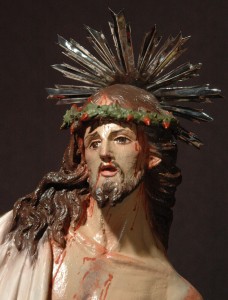 li kienu jintużaw ġol-knejjes. Hawnhekk kull sena nagħmlu xi ħaġa ġdida u ċertu nies jiġu letteralment biex jaraw din il-parti. Għaldaqstant ma nistax niżvela ħafna minn dak li ser jaraw. Nista’ però nsemmilek illi fostom ser ikun hemm kollezzjoni ta’ kurċifissi antiki maħduma minn materjali differenti u li wħud minnhom imorru lura għal aktar minn 300 sena. Kważi daqstant antik ser isibu wkoll vestwarju li kien jintlibes mill-qassisin fiż-żminijiet tal-Ġimgħa l-Kbira. Ser ikun hemm ukoll għadd ta’ platti tal-ismid, kollha maħdumin mill-membri tagħna.”
li kienu jintużaw ġol-knejjes. Hawnhekk kull sena nagħmlu xi ħaġa ġdida u ċertu nies jiġu letteralment biex jaraw din il-parti. Għaldaqstant ma nistax niżvela ħafna minn dak li ser jaraw. Nista’ però nsemmilek illi fostom ser ikun hemm kollezzjoni ta’ kurċifissi antiki maħduma minn materjali differenti u li wħud minnhom imorru lura għal aktar minn 300 sena. Kważi daqstant antik ser isibu wkoll vestwarju li kien jintlibes mill-qassisin fiż-żminijiet tal-Ġimgħa l-Kbira. Ser ikun hemm ukoll għadd ta’ platti tal-ismid, kollha maħdumin mill-membri tagħna.”Ryan qalli illi t-tradizzjoni tal-platti tal-ismid inbdiet f’Ħaż-Żebbuġ u llum daħlet f’ħafna rħula oħra. Huwa xogħol ta’ paċenzja kbira imma r-riżultat tiegħu huwa mpressjonanti u mill-isbaħ (kif qagħad jurini Christian Brincat li biex ifehemni kif isir dan ix-xogħol, beda jżejjen platt tal-appostli quddiemi). Għal dis-sena wieħed mill-attrazzjonijiet ser ikun platt ta’ ftit akbar minn metru maħdum bis-smid u mibni fuq kwadru. Huwa x-xogħol ta’ żgħażugħ ta’ 21 sena, Emmanuel Spiteri…
“Domt naħdem fuqu ġimgħatejn, erbgħa siegħat kuljum. Huwa xogħol li trid attenzjoni u paċenzja kbira għalih imma li jekk tagħmlu bil-qalb, wara jagħtik sodisfazzjon kbir. Tgħallimt dis-sengħa
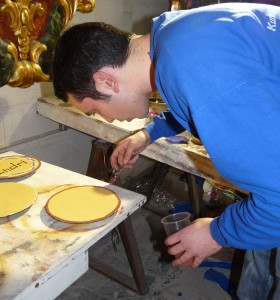 hawnhekk, fil-maħżen tal-Kummissjoni. Oriġinarjament aħna konna nqabbdu lil ħaddieħor biex jagħmlilna dawn il-platti. Ġara li darba minnhom dan l-individwu ma setax jaqdina bħas-soltu u sħabi ħajjruni nipprova nagħmel xi ħaġa jien. Jiena kont ilni ninnota kif isir dax-xogħol għax l-arti minn dejjem togħġobni. Iddeċidejt li nipprova u ftit ftit irnexxieli naħdem l-ewwel platti sakemm bil-mod bnejt it-tattika partikolari tiegħi. Is-sigriet qiegħed fil-kapaċità ta’ kif tħallat u tpoġġi l-kuluri fuq il-platti. Kemm ilni membru fil-Kummissjoni tgħallimt ħafna minn sħabi akbar minni. Fil-fatt hawnhekk tħarriġt ukoll fis-sengħa tal-ixkatlar li aktar il-quddiem wasslitni biex sibt xogħol f’dan il-qasam.”
hawnhekk, fil-maħżen tal-Kummissjoni. Oriġinarjament aħna konna nqabbdu lil ħaddieħor biex jagħmlilna dawn il-platti. Ġara li darba minnhom dan l-individwu ma setax jaqdina bħas-soltu u sħabi ħajjruni nipprova nagħmel xi ħaġa jien. Jiena kont ilni ninnota kif isir dax-xogħol għax l-arti minn dejjem togħġobni. Iddeċidejt li nipprova u ftit ftit irnexxieli naħdem l-ewwel platti sakemm bil-mod bnejt it-tattika partikolari tiegħi. Is-sigriet qiegħed fil-kapaċità ta’ kif tħallat u tpoġġi l-kuluri fuq il-platti. Kemm ilni membru fil-Kummissjoni tgħallimt ħafna minn sħabi akbar minni. Fil-fatt hawnhekk tħarriġt ukoll fis-sengħa tal-ixkatlar li aktar il-quddiem wasslitni biex sibt xogħol f’dan il-qasam.”L-iskop oriġinali tal-Kummissjoni Festa Esterna – Fgura huwa li ttella’ l-festa ta’ dan ir-raħal imma l-għan tagħha jmur aktar minn hekk.
“Permezz tal-maħżen tal-armar, aħna niġbru ż-żgħażagħ aktar lejna u nżommuhom il-bogħod mill-inkwiet u l-vizzji ħżiena. Nitgħallmu diversi snajja’ flimkien u fl-istess ħin nieħdu pjaċir naħdmu kollha għal għan wieħed. Tista’ tgħid li f’dal-maħżen prattikament niġu kuljum għax dejjem inkunu għaddejjin fuq xi proġetti ġodda.
Is-sena 2010 hija sena importanti ħafna għall-Fgura minħabba li dis-sena ser ikunu qegħdin qegħdin jiġu ċċelebbrati bosta anniversarji sinifikattivi għall-għaqdiet tal-parroċċa fostom il-25 sena mill-ftuħ mill-każin tal-banda imma b’mod speċjali l-anniversarju tal-50 sena mill-wasla tal-vara titulari tal-Madonna tal-Karmnu. Fil-fatt f’Ottubru li ġej ser inkunu qed intellgħu wirja Marjana fuq statwi antiki li jirrappreżentaw lill-Madonna. U kif qed insemmu dan, ta’ min navżaw ukoll li dis-sena l-festa tal-Fgura mhux ser tiġi ċċelebbrata fit-tieni Ħadd ta’ Lulju kif isir is-soltu, imma minflok ser issir fl-1 t’Awwissu 2010.”
B’entużjażmu kbir, Ryan u sħabu dawwruni mal-imħażen fejn rajt uħud mix-xogħolijiet li kienu qed isiru fostom dak tal-induratura u l-fibre. Kien hemm membri ta’ kull età, saħansitra tfal żgħar li kienu qed jaħdmu fuq liedna twila.
“Aħna nilqgħu lil kull min juri interess li jixtieq jaħdem magħna,” qalli Ryan. “U mhux nies mill-Fgura biss huma membri ta’ din il-Kummissjoni. Kull fil-għaxija, għall-ħabta tal-5:00pm, niftħu l-bibien
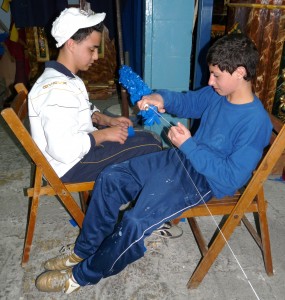 tal-maħżen u tara l-membri ġejjin, kulħadd iddedikat fuq xogħolu għax kull wieħed minnhom għandu xi parti li hu responsabbli minnha. Hawnhekk jiġu nies li bosta drabi lanqas ikunu jafu li għandhom l-arti fihom iżda mbagħad maż-żmien toħroġ b’mod naturali peress li hawn l-ambjent iħajjrek tmidd idejk. Nagħmlu dax-xogħol għax inħobbu l-armar għax mill-bqija hawn kollha volontarji. Huwa xogħol impenjattiv li jagħtik sodisfazzjon kbir. Tagħmel ukoll ħafna kuraġġ meta tara ż-żgħażagħ jaħdmu bil-ħerqa.
tal-maħżen u tara l-membri ġejjin, kulħadd iddedikat fuq xogħolu għax kull wieħed minnhom għandu xi parti li hu responsabbli minnha. Hawnhekk jiġu nies li bosta drabi lanqas ikunu jafu li għandhom l-arti fihom iżda mbagħad maż-żmien toħroġ b’mod naturali peress li hawn l-ambjent iħajjrek tmidd idejk. Nagħmlu dax-xogħol għax inħobbu l-armar għax mill-bqija hawn kollha volontarji. Huwa xogħol impenjattiv li jagħtik sodisfazzjon kbir. Tagħmel ukoll ħafna kuraġġ meta tara ż-żgħażagħ jaħdmu bil-ħerqa.Għall-ewwel darba dis-sena, flimkien ma’ din il-wirja tal-Ġimgħa Mqaddsa ser issir ukoll rappreżentazzjoni ħajja bl-għajnuna tal-atturi tal-Fgura Paegant Group. Il-Ħamis 25 ta’ Marzu 2010 ser issir it-tisliba (wara l-ftuħ uffiċċjali tal-wirja). Imbagħad ser ikun hemm rappreżentazzjoni ta’ ċenaklu ħaj fl-1 t’April 2010 (Ħamis ix-Xirka) mit-8:00pm il-quddiem u l-għada t-2 t’April 2010 (il-Ġimgħa l-Kbira) mid-9:00am sa nofsinhar.
Din il-wirja ser tittella’ fil-Knisja l-Qadima tal-Fgura. Ftuħ: il-Ħamis 25 ta’ Marzu 2010 mis-7:00pm sat-8:30pm; il-Ġimgħa 26 ta’ Marzu 2010 mill-5:30pm sad-9:00pm; is-Sibt 27 u l-Ħadd 28 ta’ Marzu 2010 mit-8:30am sa nofsinhar u mis-6:00pm sat-8:00pm; it-Tnejn 29 u t-Tlieta 30 ta’ Marzu 2010 mis-6:00pm sat-9:00pm; l-Erbgħa 31 ta’ Marzu 2010 mis-6:00pm sad-9:30pm; il-Ħamis l-1 t’April 2010 mit-9:00am sa nofsinhar u mis-6:00pm sal-11:00pm u l-Ġimgħa 2 t’April 2010 mit-8:00am sa nofsinhar.
(Dan l-artiklu ġie ppubblikat fit-Torċa tal-21 ta’ Marzu 2010)
Travelogue
Archives
| M | T | W | T | F | S | S |
|---|---|---|---|---|---|---|
| « Jan | ||||||
| 1 | 2 | 3 | 4 | 5 | 6 | 7 |
| 8 | 9 | 10 | 11 | 12 | 13 | 14 |
| 15 | 16 | 17 | 18 | 19 | 20 | 21 |
| 22 | 23 | 24 | 25 | 26 | 27 | 28 |
| 29 | 30 | 31 | ||||
Recent Posts
- A MATTER OF FATE
- MALTA’S PREHISTORIC TREASURES
- THE MAGIC IS IN THE DETAIL
- THE SELLING GAME
- NEVER FORGOTTEN
- Ġrajjiet mhux mitmuma – 35 sena mit-Traġedja tal-Patrol Boat C23
- AN UNEXPECTED VISIT
- THE SISTERS OF THE CRIB
Comments
- Pauline Harkins on Novella – Li kieku stajt!
- admin on IL-KARNIVAL TRAĠIKU TAL-1823
- Albert on IL-KARNIVAL TRAĠIKU TAL-1823
- Martin Ratcliffe on Love in the time of war
- admin on 24 SENA ILU: IT-TRAĠEDJA TAL-PATROL BOAT C23